Halifax Corporation Tramways
History
In the last decades of the 19th Century, Halifax was unusual in being a major industrial town without a tramway of any kind, chiefly due to the terrain, which comprised a series of steep hills and valleys, making it unsuitable for either horse or steam traction. Although several proposals were made to build company-owned electric and cable tramways in the town, none succeeded, the corporation eventually deciding — on the 5th January 1897 — that it would apply for powers to build and operate a system itself, though it ended up hedging its bets by not stipulating the means of traction it would use.
Powers to build 3.1 miles of 3ft 6ins-gauge tramway were granted on the 15th July 1897, under the Halifax Corporation Tramways Act, 1897. The narrow gauge was doubtless due to the narrowness of many of the streets, though it was to have long-term consequences, as not only did the Board of Trade dislike the use of top-covered double-deck trams on a such a narrow gauge, especially given the exposed hills, but also, there could be no inter-running with the neighbouring systems of Bradford and Huddersfield, both of which had been built to wider gauges.
Construction commenced on the 30th August 1897, the corporation having finally made up its mind to use overhead electric traction rather than the much more expensive option of cable haulage. The first services, to Highroad Well and to Kings Cross, opened for business on the 29th June 1898, both routes being extended to the station three weeks later on the 20th July. By this time, the corporation was thinking well ahead, having already submitted a bill to parliament to build a further 12 miles of tramway, which was passed into law on the 25th July 1898, under the Halifax Corporation Act, 1898.
The following year, new lines were opened to Salterhebble, Skircoat Green, Boothtown, Kings Cross (via Savile Park), Pellon, Masons Green and Illingworth. The first services were worked by ten tramcars, which were joined by four more in late 1898, thirty in 1899 and fourteen in early 1900, bringing the passenger tramcar fleet up to 58 vehicles.
Powers to build yet more lines were obtained on the 1st August 1899 (under the Tramways Orders Confirmation [No 1] Act, 1900) and again on the 6th August 1900 (under the Halifax Corporation Act, 1900). The latter year saw a further significant expansion in services, with new lines and extensions opening to West End, Causeway Foot, Tuel Lane, Stocks Gate, and Stump Cross. In 1901, these were followed by extensions to Luddendenfoot, Northowram, Queensbury, Shelf, Mytholmroyd, Fallingroyd Bridge, and Southowram. At Queensbury and Shelf, Halifax's tracks eventually met the 4ft-gauge system of Bradford Corporation Tramways, which was already running to the latter (steam-operated), and would eventually open overhead electric lines to both; the two systems were, however, never connected due to the difference in the gauges, the BCT's system being 4 feet. The tracks within Queensbury were built with powers that had been granted to the Urban District Council on the 9th August 1899 — under the Tramways Orders Confirmation (No 2) act, 1899 — but which had subsequently been transferred to Halifax and Bradford Corporations.
In 1902/3 tramway extensions were opened to Hebden Bridge, Hipperholme, Hove Edge and Sowerby Bridge, with the tramcar fleet being expanded accordingly, by seven cars in 1901, 18 cars in 1902, and 12 cars in 1903. In 1902, the tramways also expanded into the operation of a parcels service, a move which proved to be very successful.
In general, Halifax Corporation had a good relationship with most of its immediate neighbours, so it was able to build tramways outside the County Borough with their support, though with the notable exception of Elland. Some of these areas passed under the control of Halifax on the 22nd July 1902, with the expansion of the County Borough boundaries by the Halifax Corporation Act, 1902; the act also conferred powers for road widening and for further tramway extensions to Todmorden and Wainstalls.
Yet more new lines were opened in 1904/5, to Brighouse, Bailiffe Bridge, Salterhebble (Jubilee Road), Triangle, and West Vale, as well as a short line along Thrum Hall Lane, all of which brought the main burst of expansion to a close. At Bailiffe Bridge and Brighouse, Halifax's tram tracks eventually met those of Bradford Corporation, and much later on, Huddersfield Corporation, the latter's sytem being standard gauge (4ft 8½ins). The tramcar fleet was expanded by two cars in 1904, which were destined to be the last new vehicles for nine years.
The system settled down to a profitable existence, though one occasionally clouded by the main council's desire to build unremunerative extensions, or to set fares at such a low level that the enterprise would struggle to make a profit. Although these requests inevitably placed the full council and the Tramways Committee at loggerheads, matters were usually resolved in favour of the tramway.
Extensions to Stainland and Elland, as well a significant track doubling, were authorised on the 18th August 1911 under the Halifax Corporation Act, 1911. The act also included borrowing powers to finance an extensive programme of tramcar top covering, as well as to operate trolleybuses (on a specific route) and motorbuses (within the borough and in connection with the tramways).
The top-covering programme commenced in 1912, and by October 1913, a total of 46 tramcars had been dealt with, the fleet being supplemented the same year by the addition of six more cars. A single motorbus was acquired to test the waters for this mode of traction, a service to Mount Tabor commencing on the 17th October 1912, with two more vehicles being placed on order. Nothing was done about the extensions to Stainland and Elland, and with the powers expiring, the corporation reconsidered its needs, applying for powers to extend the time allowed to build the Stainland extension, but allowing the Elland powers to lapse. Additionally, the act changed the routes on which trolleybuses could be used, and extended the motorbus powers so that the corporation could operate anywhere within the borough, and to a small number of specified destinations outside it. These powers were granted on the 24th June 1915 under the Halifax Corporation Act, 1915.
The outbreak of the Great War had a dramatic effect on the tramway, both through the loss of tramway employees (and their skills) to the armed forces, and as a consequence of the severe restrictions on spares and new materials. Maintenance had therefore, to be kept to the bare minimum, which together with the heavy war-time loadings had a particularly deleterious effect on the condition of the track and the vehicles. Additionally, any thoughts of building the extension to Stainland, or commencing trolleybus services, had to be placed in abeyance.
By the end of the war, the system was in poor shape, and though the council did accede to the Tramways Committee requests to replace some of the track, and to purchase new and more powerful tramcar motors, it would not countenance an increase in fares at a time of high inflation; this decision placed the entire enterprise in a precarious financial position, as it was unable to meet its debt repayments, let alone build up a reserve fund to address the looming spectre of life-expired track and tramcars. Two trolleybuses were finally acquired secondhand from Dundee Corporation in 1918, though it was to be almost three years before they were placed into operation on the Wainstones route, on the 20th July 1921.
The new line to Stainland was opened in May 1921, with the council finally agreeing to borrow a quarter of a million pounds to finance reconstruction of four of the most worn-out routes. Seven new tramcars were built by the corporation between 1921 and 1923, with another three following between 1924 and 1926; this was, however, insufficient to replace what was by this time an aged fleet.
A new trolleybus was acquired in 1924 to join the two existing vehicles that were shaking themselves, and their passengers, to pieces on the appalling road to Wainstones, but this was to be the corporation's last trolleybus purchase, services only lasting to 1926.
Competition from independent motorbus operators was by now making itself felt, including the operations of O & H Holdsworth, who operated illegally, and seemingly with impunity, neighbouring authorities freely granting them licences to operate outside the borough, and in competition with several tram routes, and magistrates levying such low fines for the frequent licence transgressions, that the company was merely encouraged to continue in the same vein. Although the corporation purchased a further 21 motorbuses in 1925 and 1926, with more to follow, they alone were insufficient to turn the tide.
By mid 1926, the long tramway line out to Hebden Bridge had been relaid, and with the opening of a short extension within Skircoat Green on the 12th June 1926, the tramway system reached its maximum size of 39.07 miles. From central Halifax, lines radiated northwards to Causeway Foot; northeastwards to Queensbury and Shelf; eastwards to Brighouse and Bailiffe Bridge; southeastwards to Southowram; southwards to Stainland and Skircoat Green; southwestwards to Triangle, westwards to High Road Well and Hebden Bridge; and northwestwards to Mount Pellon. In addition, there were a number of interconnecting lines.
The tramway was by now in serious financial difficulties (making another loss in 1926), with the independent motorbus operators, which freely used the roads the tramways were required to maintain, siphoning off significant numbers of tramway passengers. In spite of these difficulties, the corporation found the money to build a further 21 new tramcars between 1928 and 1930).
Powers were obtained on the 10th May 1929 — under the Halifax Corporation Act, 1929 — to operate municipal motorbuses along the tramway routes outside the borough (without unwarranted interference from local councils), and to replace tramway services with motorbuses, as it saw fit. The first closure did not take long to occur, trams between Brighouse and Bailiffe Bridge being withdrawn on the 30th March 1929.
The heady days of unregulated independent motorbus operation were, however, coming to an end. In 1929, Holdsworth's, which had by this time had morphed into Hebble Motor Services, was bought up by the London, Midland and Scottish, and London North Eastern Railway Companies, recently enacted legislation (in 1928) enabling them to take over road operators. The railway companies quickly approached Halifax Corporation with proposals for joint working, agreement eventually being reached that effectively allocated receipts for the Halifax sections of all bus routes to the corporation, but much less revenue earned outside the municipal boundary; the services were overseen and delivered by the Halifax Joint Omnibus Committee, which contained representatives of all parties.
In 1930, the tramways finally made a small profit, though this was more than offset by the losses on the corporation buses. On the 30th December 1930, the corporation decided that it would abandon the outlying and unprofitable tramway lines as and when the infrastructure wore out, in order to concentrate its resources, on the profitable core of the system.
The following year saw the arrival of four second-hand trams from Exeter Corporation Tramways, but the closure of the lines from Hove Edge to Brighouse, to Southowram, and from Kings Cross via Savile Row; despite these closures, a further loss was made during the year. More abandonments followed in 1932 (to Skircoat Green, and to Northowram) and 1933 (lines to Shelf and Hipperholme). The latter year also saw the appointment of a new General Manager who, whilst not rocking the boat, clearly saw the future as one in which transport provision would be exclusively provided by motorbuses.
More closures followed in 1934 (Stump Cross, Queensbury, Triangle, Boothtown and Stainland), the fleet being reduced to 56 cars. Tellingly, the Boothtown line was closed despite the fact that it was operated at a profit. This was merely a portent of what was to come, the line to Salterhebble closing in 1935, and the long line out to Hebden Bridge following in 1936, despite the track having over seven years of life left in it before it needed replacement.
In recognition of the switch to motorbus operation, the Tramways Committee was renamed Halifax Passenger Transport Committee on the 17th October 1937. The following year saw the closure of the lines to Causeway Foot, Pellon, Highroad Well, Tuel Lane and Sowerby Bridge, and the reduction of the tramcar fleet to just 15 cars.
The last tram of all ran on the 14th February 1939 on the Masons Green route. Overall, the tramway had been a profitable concern that had provided cheap travel to the citizens of Halifax and several of the neighbouring communities for the best part of forty years, and though some of its debts were still outstanding at closure, this was only due of the abstraction of over £80,000 from the profits to subsidise the municipal rates.
Uniforms
The photographic record for Halifax Corporation Tramway is extremely heavily weighted to the first decade of operation, with the subsequent thirty years being rather sparsely represented, particularly in respect of senior staff and female Great War employees.
For the inauguration of electric services in 1898, tramcar staff were issued with smart, single-breasted, three-quarter-length, navy-blue coats with lapels; the collars carried an employee number on the bearer's right-hand side in individual numerals, presumably brass to match the buttons (see link). Wing collar shirts, ties and waistcoats were also worn, the latter probably issued by the corporation. The caps, which were in a kepi style, carried a script-lettering grade badge — either 'Driver' or 'Conductor' — more than likely in brass. At some point in the first few years of operation, and certainly by 1900, the employee number migrated to the cap, and was worn beneath the grade badge, leaving the jackets completely devoid of insignia (other than the buttons).
The three-quarter-length coats appear to have fallen out of use between 1904 and 1906, being superseded by shorter single-breasted jackets with five buttons and lapels, again without badges of any kind. The caps were changed at the same time to a peaked type with a tensioned crown (top), and whilst the employee number continued to be carried, the script-lettering grade badges were dispensed with. These uniforms appear to have remained unaltered — stylistically — right through to the 1920s (probably to the 1930s for conductors). The sole change was the introduction of a new voided cap badge (possibly in the years immediately before the Great War), which incorporated a municipal device within a circular border containing the full system title — 'HALIFAX CORPORATION TRAMWAYS' — the latter inlaid with blue enamel, and with an employee number in a lozenge-shaped surround beneath. There is reason to believe that motormen were issued odd numbers and conductors even numbers, though documentary evidence has so far proven elusive.
A single photograph has survived from the 1920s showing a motorman in a lancer-style tunic, so it is possible that this style of jacket was issued at some point during that decade, at least for that grade. The uniforms were changed to a more modern cut in the late 1920s/early 1930s; the jackets were now single-breasted with four buttons, two hip-level pockets (with flap closures), two breast pockets (with button closures) and lapels. Later photographs show tramcar crews wearing peaked caps with woven straw tops, which unlike other systems, appear to have been worn all year round rather than just in summer.
For most of the system's life, tramcar crews were also issued with double-breasted greatcoats with five pairs of buttons and high, fold-over collars; other than the buttons, these coats were devoid of insignia.
Photographs of inspectors are rare, so all that can be stated with certainty is that during the 1920s, they were wearing drooping-peak caps. These caps almost certainly bore a similar badge to the tramcar-crew caps, but without the employee number. It is probable, but by no means certain, that in the last few years of tramway operation, inspectors were issued with single-breasted jackets bearing five black unmarked buttons, two breast pockets (with button-closed flaps) and lapels; the collars carried the grade — 'Inspector' — in embroidered-script lettering. The drooping-peak caps were at some point superseded by tensioned-crown peaked caps, which bore the same pattern of badge as the earlier caps, though possibly in chrome rather than brass. Inspectors would very likely have also been provided with gabardine-style topcoats, which do not appear to have borne any insignia.
Halifax employed female staff during the Great War to replace men lost to the armed services, but only as conductresses (the first 15 in November 1915), and at least one inspectress (a Mrs O. Smith). To date, not a single photograph of one of these ladies has come to light, so it is currently impossible to say what uniforms they wore.
Further reading
For more information on the tramway see: 'Halifax Corporation Tramways' by Eric Thornton and Stanley King; Light Rail Transit Association (2005).
Images
Motormen and conductors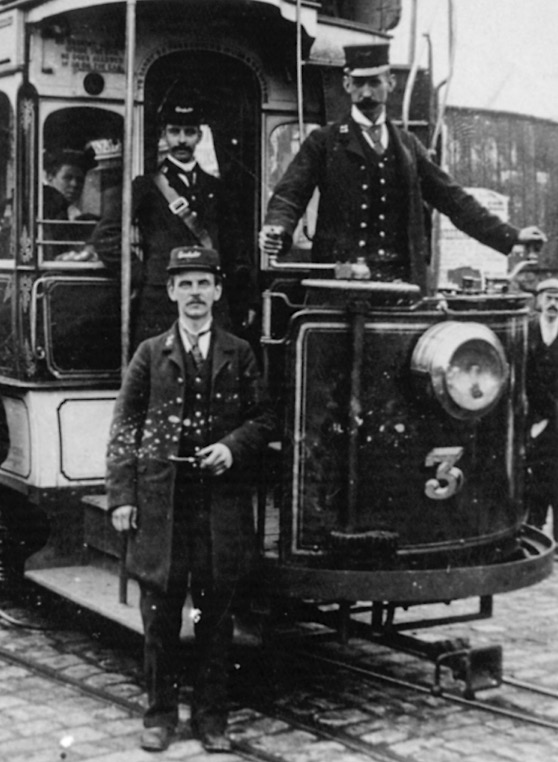
Two conductors and a motorman, all in three-quarter-length coats and kepi-style caps, pose with Tramcar No 3, almost certainly on the opening day of the Highwell Road to Old Station service (July 1898). All those depicted are wearing script-lettering grade badges. Photo courtesy of the Tramways and Light Railway Society, with thanks to David Voice.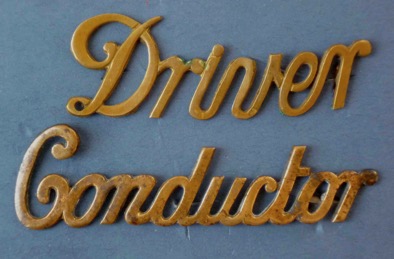
Standard script-lettering cap badges of the pattern used by Halifax Corporation Tramways in the early years of operation (1898 to around 1905) — brass. Author's Collection.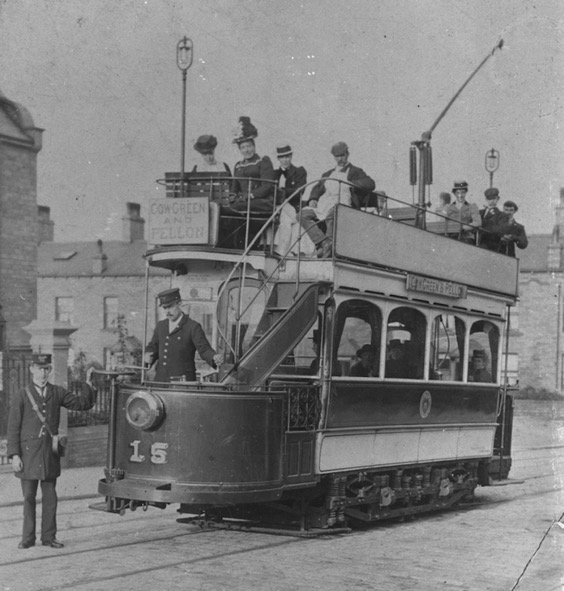
A conductor and a motorman pose with Tramcar No 15 on a service to Cow Green and Pellon — photo undated, but probably taken in late 1899 or early 1900. Photograph courtesy of the National Tramway Museum.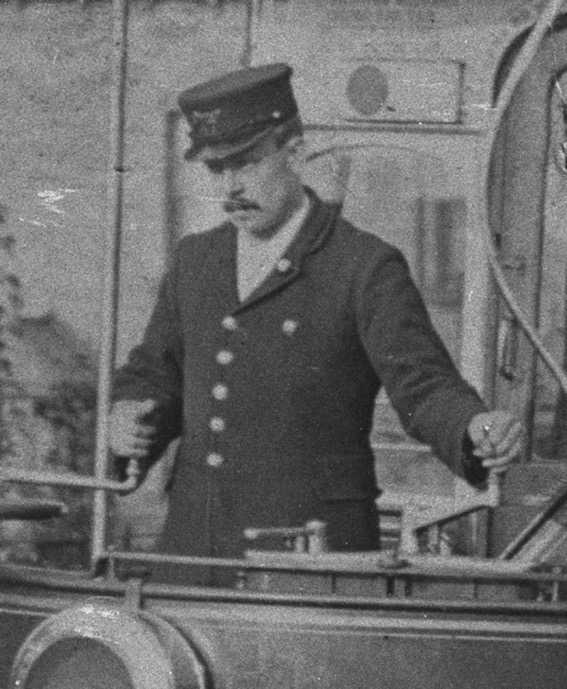
An enlargement of the above photograph showing the motorman. By this time the employee number was being worn underneath the script-lettering grade badge, with the jacket left plain. 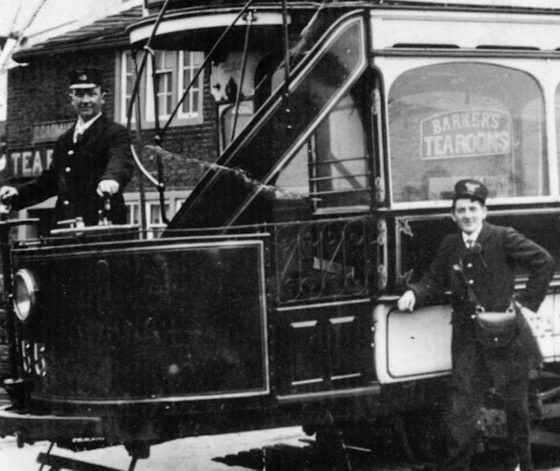
The crew of Tramcar No 55, newly fitted with a Tidswell lifeguard, captured for posterity at Causeway Foot — photo undated, but probably taken in 1902. Photo courtesy of the Tramways and Light Railway Society, with thanks to David Voice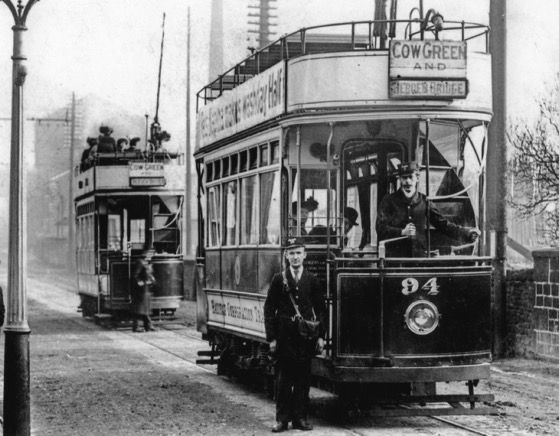
A conductor (Employee No 14) and a motorman (Employee No 5) pose for the camera with Tramcar No 94 on a service bound for Hebden Bridge — photo undated, but probably taken not long after the delivery of No 94 in 1903. Author's Collection.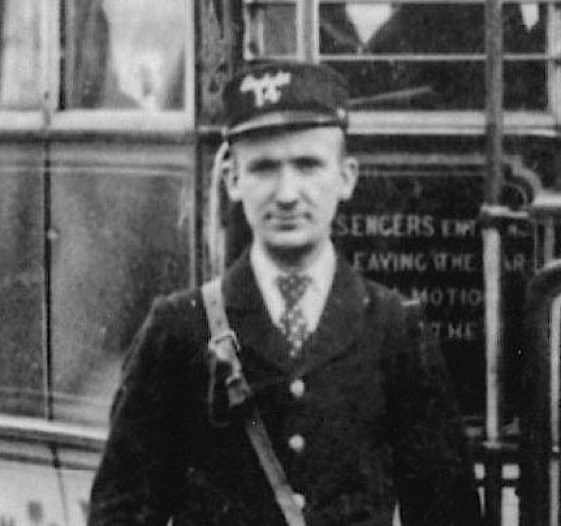
An enlargement of the above photograph showing the conductor (Employee No 14), who is wearing a kepi-style cap, 'Conductor' grade badge and employee number. Apart from the buttons, his jacket is plain.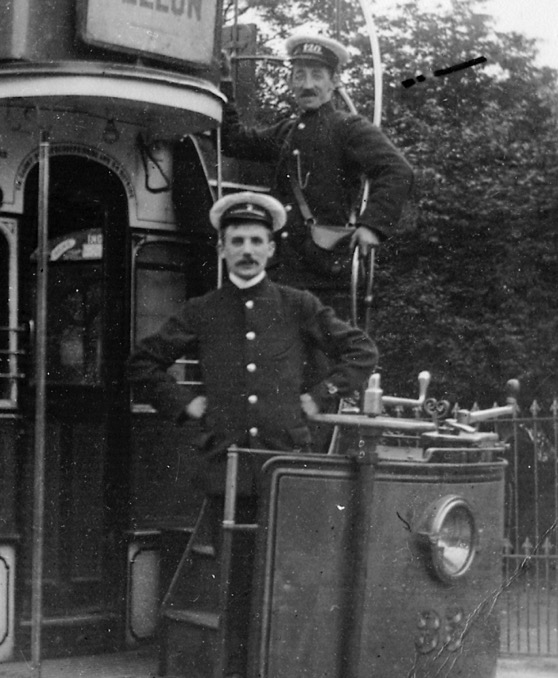
A charming study of the crew of Tramcar No 35 (Employees No 3 and No 120) — bound for Pellon — photo undated, but probably taken in 1905/6. Both men are wearing tensioned-crown peaked caps rather than the earlier kepis, but without a grade badge. Photo courtesy of the Tramways and Light Railway Society, with thanks to David Voice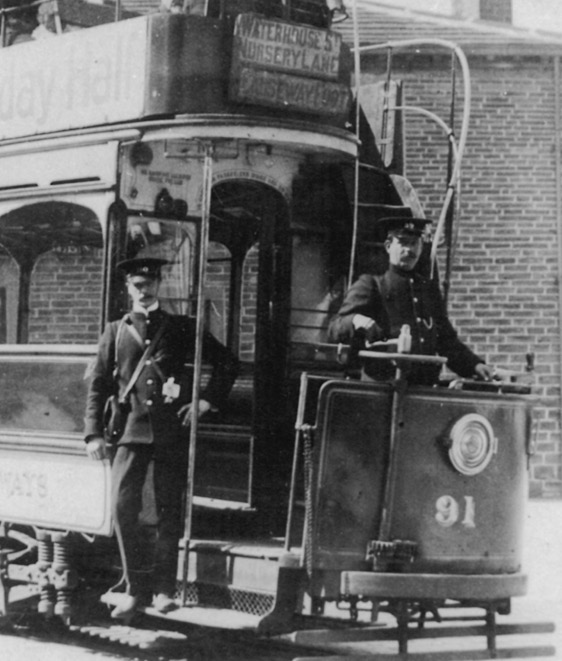
A conductor and a motorman pose for the camera at what is probably Causeway Foot — photo undated, but likely to be mid Edwardian. Again, both men are wearing tensioned-crown peaked caps that bear only employee numbers. Photo courtesy of the Tramways and Light Railway Society, with thanks to David Voice.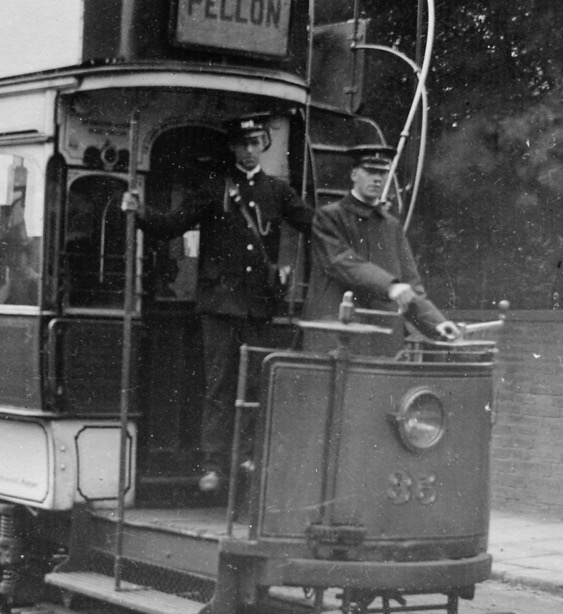
Tramcar No 35 again, and at the same location as shown above — photo undated, but probably mid-to-late Edwardian. Photo courtesy of the Tramways and Light Railway Society, with thanks to David Voice.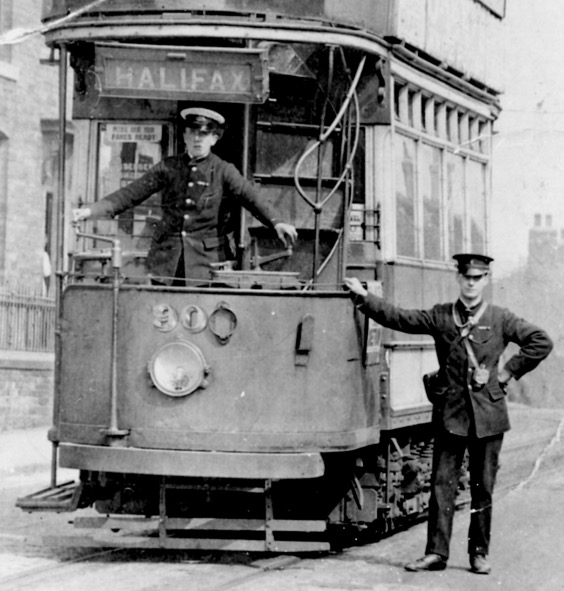
A rather dreary looking Tramcar No 90 in wartime grey livery — photo undated, but certainly taken during the Great War or shortly afterwards (both men have medal ribbons). The motorman appears to be wearing the new style of cap badge incorporating the Halifax municipal device, full system title and employee number. Photo courtesy of the Tramways and Light Railway Society, with thanks to David Voice.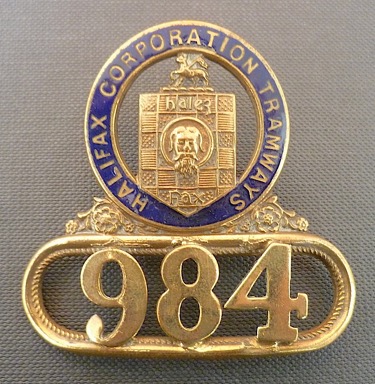
Halifax Corporation Tramways conductor’s cap badge (even number) — brass. This pattern of badge was introduced around the time of the Great War, and was probably superseded by a chrome version in the mid 1930s. Author's Collection.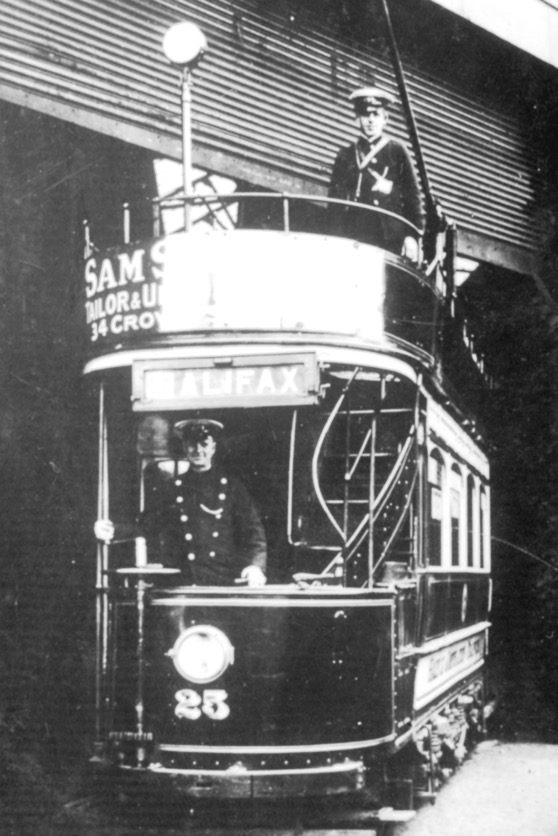
Tramcar No 25 and crew — photo undated, but probably taken in the 1920s at Skircoat depot. The motorman is wearing a distinctive lancer-style tunic. Photo courtesy of the Tramways and Light Railway Society, with thanks to David Voice.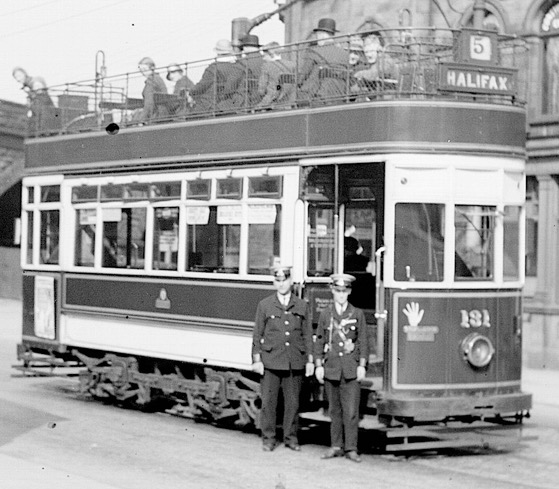
The crew of Tramcar No 131 — recently purchased from Exeter Corporation Tramways — are captured by the camera of Dr H Nicol at Sowerby Bridge on 10th July 1932. Photo courtesy of the National Tramway Museum.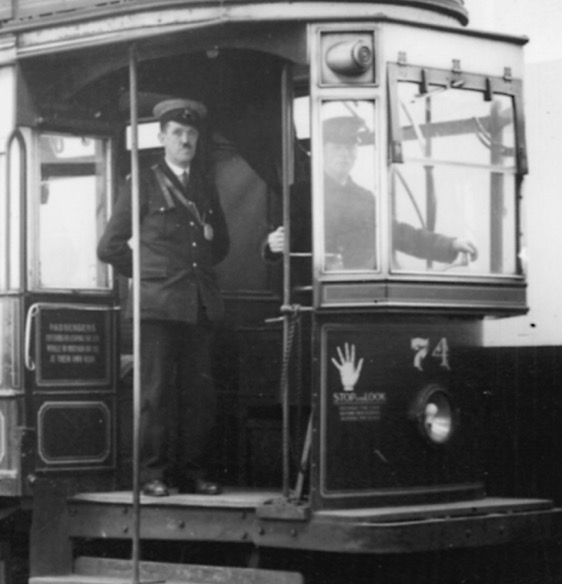
A conductor and a motorman on the platform of a vestibuled No 74. Although the destination reads 'Brighouse' (not shown), which was closed in 1931, the photo was probably taken in the mid-to-late 1930s, with the destination set to Brighouse at the behest of the photographer, W A Camwell. Photo courtesy of the Tramways and Light Railway Society, with thanks to David Voice.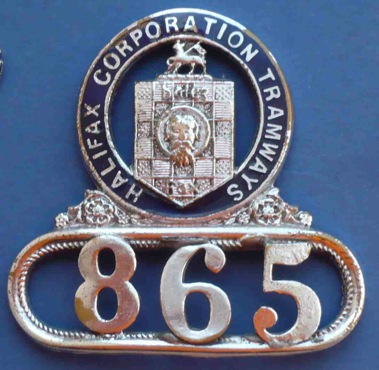
Halifax Corporation Tramways motorman’s cap badge (odd number) — chrome and blue enamel. Chrome badges were probably introduced in the mid 1930s. Author's Collection.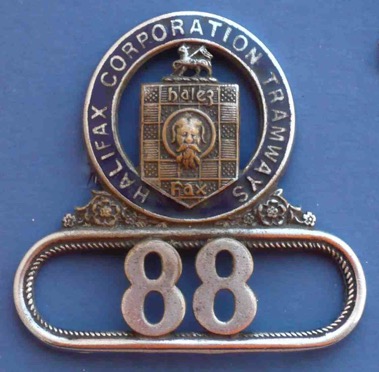
Halifax Corporation Tramways conductor’s cap badge (even number) — chrome and blue enamel. Author's Collection.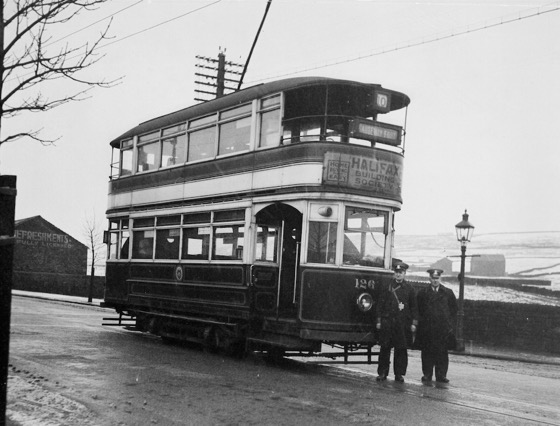
Tramcar No 126 is pictured at the Causeway Foot terminus on a wintry day in the late 1930s (probably in 1937). Photograph by W A Camwell, courtesy of the National Tramway Museum.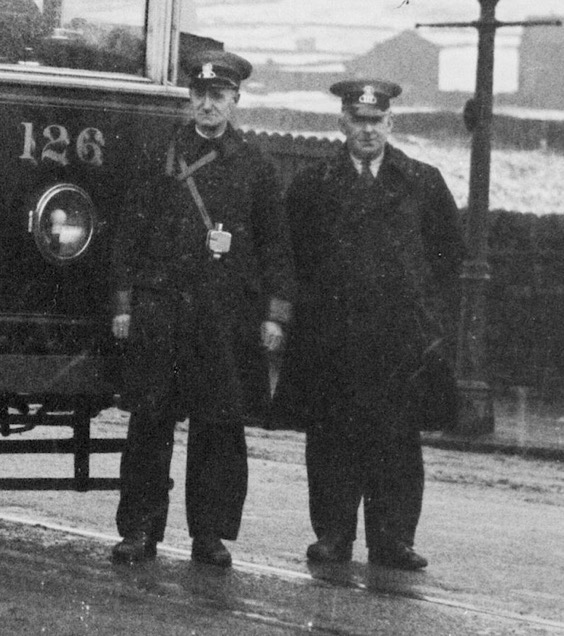
An enlargement of the above photograph, showing the crew, both of whom, needless to say, are in greatcoats.
Senior staff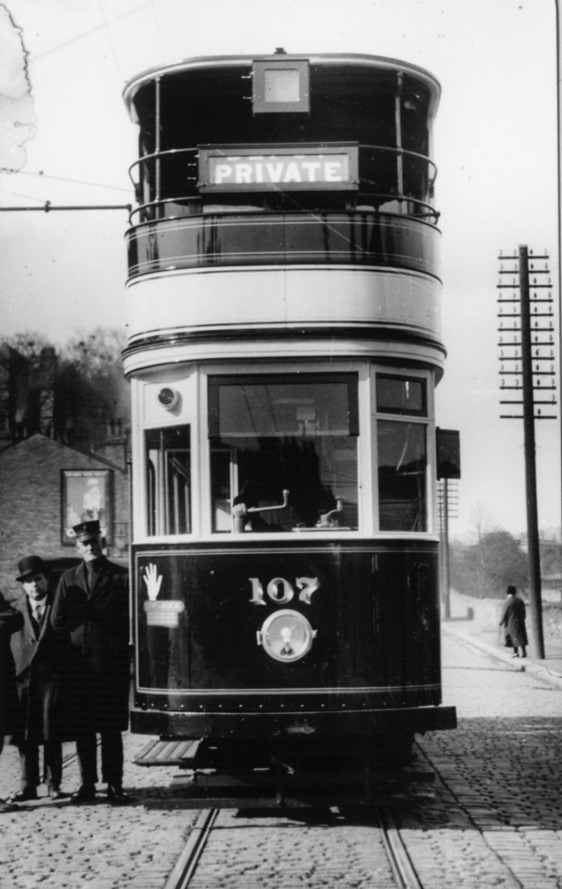
Tramcar No 107 on a test journey in April 1928, possibly pictured at Martin's Nest, Brighouse. Photo courtesy of the Tramways and Light Railway Society, with thanks to David Voice.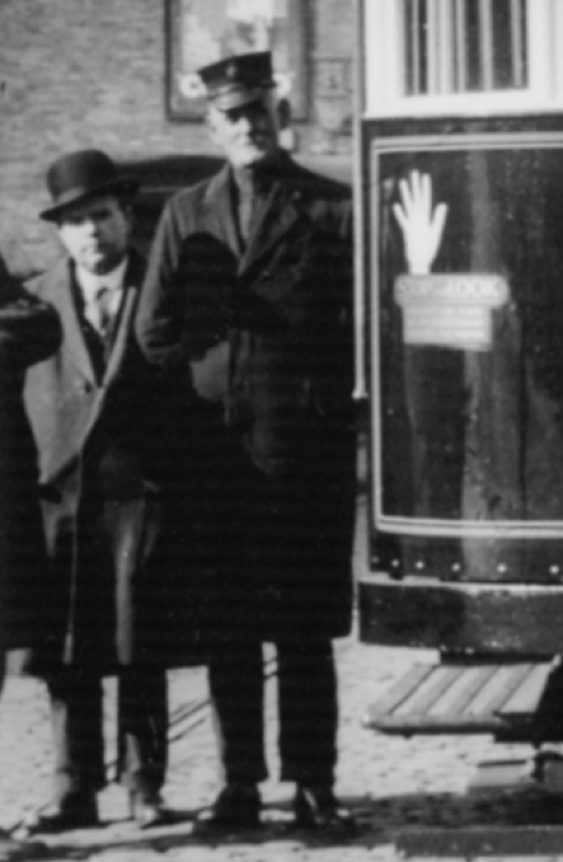
An enlargement of the above photograph showing Mr Canning (left), the Rolling-Stock Engineer, and a figure who is in all probability, an inspector.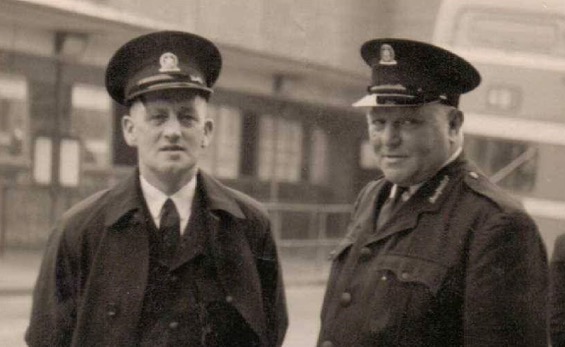
A photograph of two Halifax Corporation Transport inspectors. Although taken after the demise of the tramway, i.e., after 1939, the uniforms probably reflect those worn during the last few years of the tramway. The caps clearly bear a cap badge similar to those worn by tramcar crewmen, but without the employee number.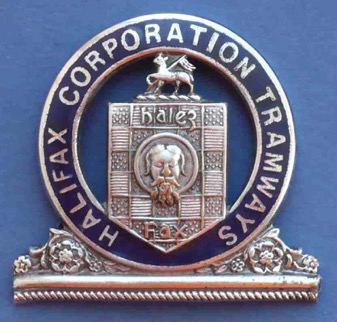
Halifax Corporation Tramways/Transport Inspector’s cap badge — chrome. Author's Collection.